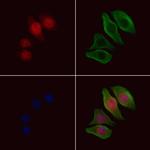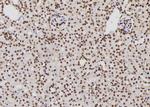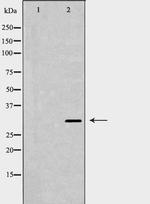Search Thermo Fisher Scientific
FIGURE: 1 / 3
XPA Antibody (PA5-102447) in ICC/IF



Product Details
PA5-102447
Species Reactivity
Host/Isotype
Class
Type
Immunogen
Conjugate
Form
Concentration
Purification
Storage buffer
Contains
Storage conditions
Shipping conditions
RRID
Product Specific Information
Antibody detects endogenous levels of total XPA.
Target Information
The XPA (xeroderma pigmentosumgroup A) protein specifically recognizes the UV-orchemically damaged DNA lesions, and triggers thenucleotide excision repair process. XPA binds to thereplication protein A (RPA) or the excision repaircross complementing 1 protein (ERCC 1). In the absence of nucleotide excision repair persisting (unrepaired) DNA lesions (adducts) may lead to the accumulation of gene mutations and ultimately to cancer. Xeroderma pigmentosum patients have a >2000 fold increased risk to develop skin cancer atsun-exposed areas.
For Research Use Only. Not for use in diagnostic procedures. Not for resale without express authorization.
References (0)
Bioinformatics
Protein Aliases: DNA repair protein complementing XP-A cells; DNA repair protein complementing XP-A cells homolog; excision repair-controlling; mutant xeroderma pigmentosum complementation group A; Xeroderma pigmentosum group A-complementing protein; Xeroderma pigmentosum group A-complementing protein homolog; xeroderma pigmentosum, complementation group A
Gene Aliases: AI573865; XP1; XPA; XPAC
UniProt ID: (Human) P23025, (Mouse) Q64267
Entrez Gene ID: (Human) 7507, (Mouse) 22590, (Rat) 298074

Performance Guarantee
If an Invitrogen™ antibody doesn't perform as described on our website or datasheet,we'll replace the product at no cost to you, or provide you with a credit for a future purchase.*
Learn more
We're here to help
Get expert recommendations for common problems or connect directly with an on staff expert for technical assistance related to applications, equipment and general product use.
Contact tech support
